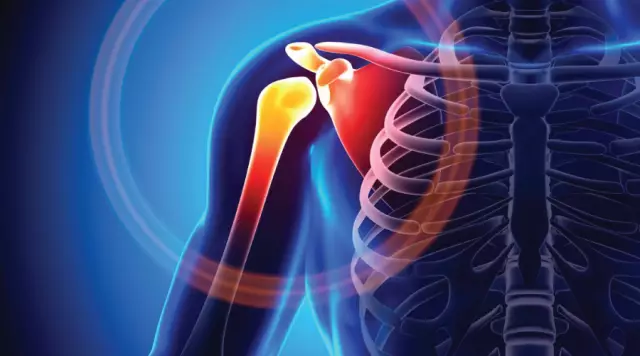- Author Rachel Wainwright [email protected].
- Public 2023-12-15 07:39.
- Last modified 2025-11-02 20:14.
Why does the nose hurt?

Nerve endings are found in all human tissues, in a state of overexcitation, any receptors: temperature, olfactory, tactile, sensory, and others - work as pain receptors. To understand why a nose or other organ hurts, it is important to imagine what tissues it consists of.
The outer part of the nose is covered with skin, the sinuses are lined with epithelium, which contains secretory cells. The bridge of the nose is formed by the bony part of the skull from above, passing into the cartilaginous plate. The septum is represented by bone tissue. The nasal passages are divided into three levels. The upper one runs in close proximity to the brain and is responsible for the sense of smell. The lacrimal gland duct flows into the lower part of the nasal passage. Therefore, the child reflexively sniffles when crying, regardless of whether his nose hurts or not.
The inside of the nose is a series of sinuses that are connected to the nasal cavity but form cavities in the front of the skull. Therefore, even when the tip of the nose hurts, sensations are transmitted throughout the skull. The head hurts due to the inflammation in the frontal sinuses. Eyes are watery and jaws hurt, as sinusitis develops.
What diseases do nose pain appear?
First of all, the nasal mucosa reacts to pain. Inflammatory processes called rhinitis develop on its surface. Types of inflammation of the nasal mucosa:
- Infectious;
- Allergic;
- Vasomotor;
- Hypertrophic;
- Atrophic;
- Specific;
- Medication.
Infectious rhinitis is caused by bacteria and viruses. Much less often, they are provoked by fungi. Once in the body, pathogenic microbes cause an inflammatory reaction. A person feels pain in the nose due to swelling of the mucous membrane. Soon, the inflammation passes into the next phase - exudation. A runny nose appears. If the disease is caused by viruses, the discharge from the nose is clear. When rhinitis is caused by bacteria, most commonly staphylococci, the nasal discharge becomes thick and greenish.
Allergic rhinitis is manifested by profuse discharge from the nose, sneezing, lacrimation. Irritation of the mucous membrane of the nasal passages leads to the fact that the nose is stuffy and sore for a long time. As a rule, allergic inflammation does not tend to self-cure until contact with the allergen is excluded.
The word "vasomotor" means "vascular" (lat. "Vase"). The disease occurs without any pathogens, is characterized by spasm followed by expansion of small vessels of the nasal mucosa. Discharge from the nose appears due to the sweating of the liquid component of the blood plasma. It is literally squeezed out of the vessels. In this case, the nose is very sore from any impact. Air temperature changes, for example. The ciliated cells of the epithelium normally absorb excess fluid, but with vasomotor rhinitis, they cannot cope with the increased volume. Such a runny nose is popularly called "cold allergy". When moving to a warm room, the signs of the disease do not disappear, since the mechanism of vascular contraction is disrupted. Throughout the entire winter season, a person has a stuffy nose and soreness for no apparent reason, even under a microscope.
Hypertrophic rhinitis is a chronic disease characterized by overgrowth of cells in the nasal mucosa, resulting in narrowing of the nasal passages. The patient's voice becomes nasal, pain in the nose becomes permanent.
Anatomically, atrophic rhinitis is the exact opposite of hypertrophic rhinitis, but its manifestations are the same. The glandular cells lose their ability to absorb exudate, resulting in a runny nose. And in the same way, the nose hurts almost constantly, regardless of the weather or infection.
Specific rhinitis is caused by certain bacteria: causative agents of leprosy, tuberculosis, syphilis. The destruction of bone tissue occurs imperceptibly and painlessly, since nerve endings die off. However, after the destruction of the septum and back of the nose, pain appears.
Medicamentous rhinitis is of a paradoxical nature. A person fights a runny nose with the help of vasoconstrictors, and gets a hypertrophic or atrophic process. The vessels are narrowed, the blood supply to the mucous membrane is disrupted. That is why the nose hurts during intensive treatment, which is accompanied by an overdose of drugs. Therefore, doctors do not recommend the abuse of nasal drops, which have vasoconstrictor effects.
Why does the nose hurt without a runny nose?
When there are no obvious signs of rhinitis, pain in the nasal area can be caused by the following reasons:
- Injury;
- Burn;
- Inflammatory processes of the skin;
- Acne;
- Herpetic infection;
- Neurological diseases.
Injury to the nose is accompanied by pain at the time of receipt and for some time, the duration of which depends on the extent of destruction. With a fracture, the nose hurts until a callus forms. This happens within three weeks, at least.
Burns, including sunburn, lead to the destruction of the epithelial cover of the skin. A similar pathology develops with frostbite. At first, the tip of the nose hurts, then the pain spreads to its wings and back.
The inflammatory processes of the skin include infectious diseases: furunculosis and streptoderma. Purulent inflammation of the hair follicles during the formation of a boil is accompanied by pain in the nose, reaching a pulsating character. With streptoderma, the skin of the nose affects a large area, but spreads to a shallower depth. Patients experience severe, painful itching.
Acne, or acne, is not painful. However, if a bacterial infection joins, which causes suppuration, the nose begins to ache.
With a herpetic lesion, the wings of the nose most often suffer, the tip of the nose affected by the virus hurts much less often. The pains are dull, accompanied by itching.
Neurological diseases of the facial part of the skull do not show signs of rhinitis either. Nevertheless, the pains are quite sharp and diffuse. The reason for this is the development of pterygopalatine ganglioneuritis. The pain begins suddenly, has a paroxysmal character. At the same time, the nose, jaws, eye sockets and even hands hurt: from the shoulder blades to the hands.

Trigeminal neuralgia is also characterized by severe, paroxysmal pain that extends to the eye sockets and forehead. Most often, attacks are observed at night. This is due to the activity of the autonomic nervous system. Patients complain that the nose hurts, but there is no runny nose, and the feeling of temporary anosmia - the inability to distinguish smells.
When the nose hurts due to inflammation of the maxillary sinuses
With sinusitis, the pain is permanent. They are often accompanied by lacrimation. The nasal cavity narrows, chronic rhinitis appears, which does not respond to therapeutic treatment. After pumping out the contents of the maxillary sinuses, the pain stops.
YouTube video related to the article:
Found a mistake in the text? Select it and press Ctrl + Enter.






